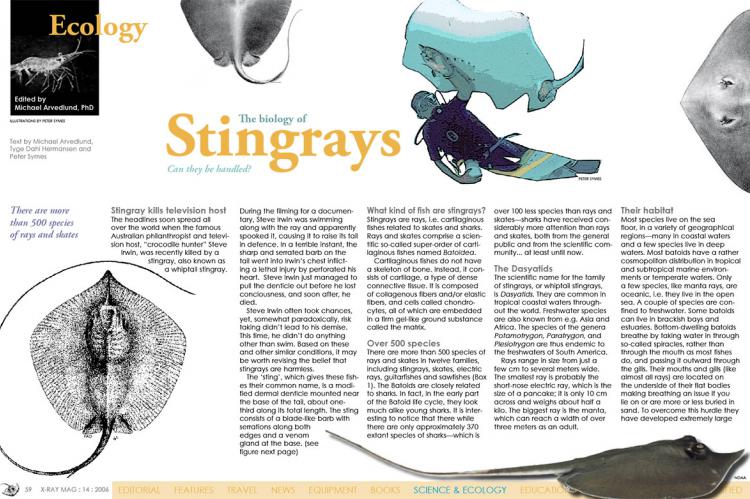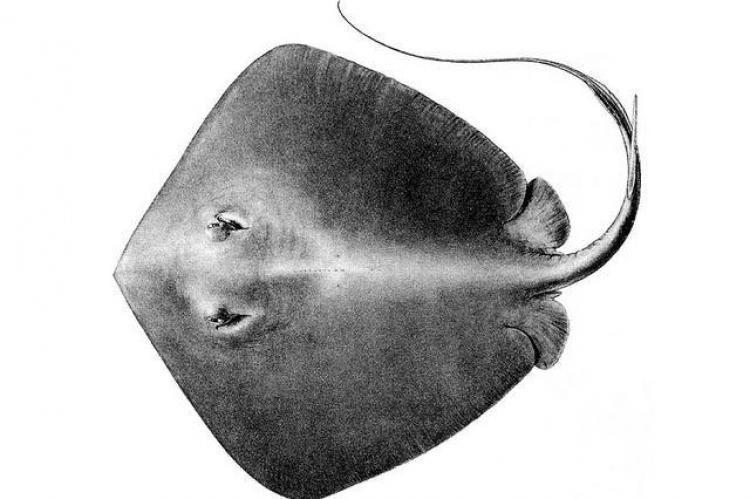Stingrays
"Stingray kills television host"
The headlines soon spread all over the world when the famous Australian philanthropist and television host, “crocodile hunter” Steve Irwin, was recently killed by a stingray, also known as a whiptail stingray.
Tags & Taxonomy
The ‘sting’, which gives these fishes their common name, is a modified dermal denticle mounted near the base of the tail, about one-third along its total length. The sting consists of a blade-like barb with serrations along both edges and a venom gland at the base. (see figure next page)
What kind of fish are stingrays?
Stingrays are rays, i.e. cartilaginous fishes related to skates and sharks. Rays and skates comprise a scientific so-called super-order of cartilaginous fishes named Batoidea.
Cartilaginous fishes do not have a skeleton of bone. Instead, it consists of cartilage, a type of dense connective tissue. It is composed of collagenous fibers and/or elastic fibers, and cells called chondrocytes,
all of which are embedded in a firm gel-like ground substance called the matrix.
Over 500 species
There are more than 500 species of rays and skates in twelve families, including stingrays, skates, electric rays, guitarfishes and sawfishes (Box 1). The Batoids are closely related to sharks. In fact, in the early part of the Batoid life cycle, they look much alike young sharks. It is interesting to notice that there while there are only approximately 370 extant species of sharks—which is over 100 less species than rays and skates—sharks have received considerably more attention than rays and skates, both from the general public and from the scientific community... at least until now.
The Dasyatids
The scientific name for the family of stingrays, or whiptail stingrays, is Dasyatids. They are common in tropical coastal waters throughout the world. Freshwater species are also known from e.g. Asia and Africa. The species of the genera Potamotrygon, Paratrygon, and Plesiotrygon are thus endemic to the freshwaters of South America.
Rays range in size from just a few cm to several meters wide. The smallest ray is probably the short-nose electric ray, which is the size of a pancake; it is only 10 cm across and weighs about half a kilo. The biggest ray is the manta, which can reach a width of over three meters as an adult.
Their habitat
Most species live on the sea floor, in a variety of geographical regions—many in coastal waters and a few species live in deep waters. Most batoids have a rather cosmopolitan distribution in tropical and subtropical marine environments or temperate waters. Only a few species, like manta rays, are oceanic, i.e. they live in the open sea. A couple of species are confined to freshwater. Some batoids can live in brackish bays and estuaries.
Bottom-dwelling batoids breathe by taking water in through so-called spiracles, rather than through the mouth as most fishes do, and passing it outward through the gills. Their mouths and gills (like almost all rays) are located on the underside of their flat bodies making breathing an issue if you lie on or are more or less buried in sand. To overcome this hurdle they have developed extremely large ....
(...)
Download the full article ⬇︎

Originally published
X-Ray Mag #14
Going Down Under: AUSTRALIA: Tiger Sharks - Byron Bay - Bondi Beach - Ningaloo Reef - Tasmania Kent Group. Ecology: Stingrays. Stop the Killings. Diving with DIABETES. Discover SOLOMON Islands. Do it Right, writes Leigh Cunningham. Photography: Profile of ScubaZoo. Shopping for the Holiday: Stocking Stuffers. Portfolio: David Pilosof: "Somebody forgot his fins?"



